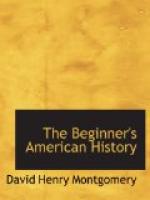The captain’s blood was on fire with rage; but he said not a word. His time had not yet come. The next day the Pilgrims and the Indians met in a log cabin. Standish made a sign to one of his men, and he shut the door fast. Then the captain sprang like a tiger at the big savage who had laughed at him, and snatching his long knife from him, he plunged it into his heart. A hand-to-hand fight followed between the white men and the Indians. The Pilgrims gained the victory, and carried back the head of the Indian chief in triumph to Plymouth. Captain Standish’s bold action saved both of the English settlements from destruction.
[Footnote 13: See Longfellow’s The Courtship of Miles Standish. This quotation is truthful in its rendering of the spirit of the words used by the Indian in his insulting speech to Standish; it should be understood, however, that the poem does not always adhere closely either to the chronology, or to the exact facts, of history.]
72. What else Myles Standish did; his death.—But Standish did more things for the Pilgrims than fight for them; for he went to England, bought goods for them, and borrowed money to help them.
He lived to be an old man. At his death he left, among other things, three well-worn Bibles and three good guns. In those days, the men who read the Bible most were those who fought the hardest.
Near Plymouth there is a high hill called Captain’s Hill. That was where Standish made his home during the last of his life. A granite monument, over a hundred feet high, stands on top of the hill. On it is a statue of the brave captain looking toward the sea. He was one of the makers of America.
[Illustration: MYLES STANDISH’S KETTLE, SWORD, AND PEWTER DISH.]
[Illustration: COPY OF MYLES STANDISH’S SIGNATURE.]
73. Governor John Winthrop founds[14] Boston.—Ten years after the Pilgrims landed at Plymouth, a large company of English people under the leadership of Governor John Winthrop came to New England. They were called Puritans,[15] and they, too, were seeking that religious freedom which was denied them in the old country. One of the vessels which brought over these new settlers was named the Mayflower. She may have been the very ship which in 1620 brought the Pilgrims to these shores.
Governor Winthrop’s company named the place where they settled Boston, in grateful remembrance of the beautiful old city of Boston,[16] England, from which some of the chief emigrants came. The new settlement was called the Massachusetts Bay[17] Colony,[18] Massachusetts being the Indian name for the Blue Hills, near Boston. The Plymouth Colony was now often called the Old Colony, because it had been settled first. After many years, these two colonies were united, and still later they became the state of Massachusetts.
[Footnote 14: Founds: begins to build.]
[Footnote 15: See footnote 4 in paragraph 62.]




